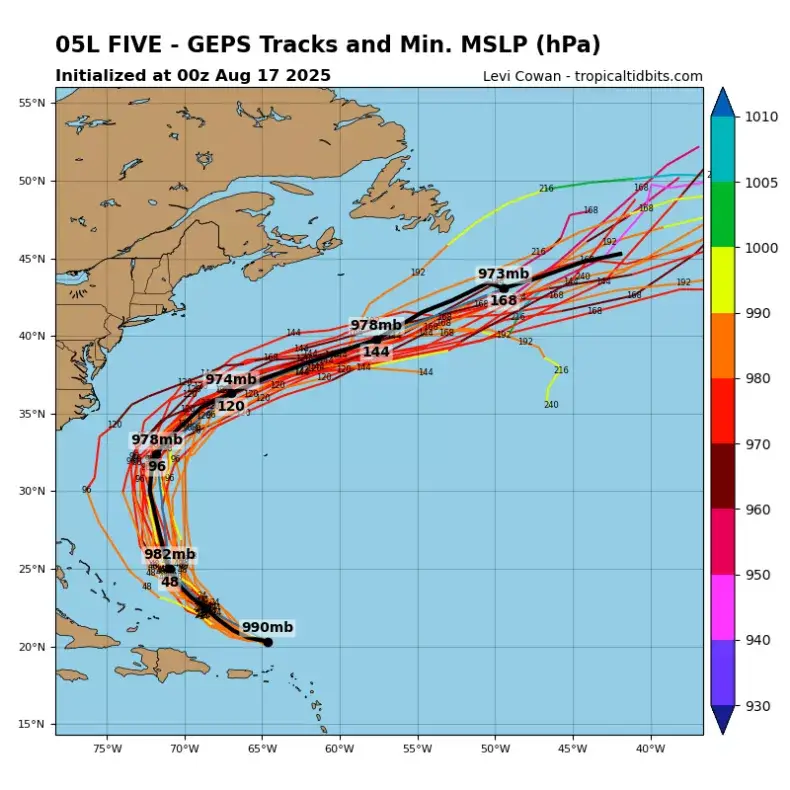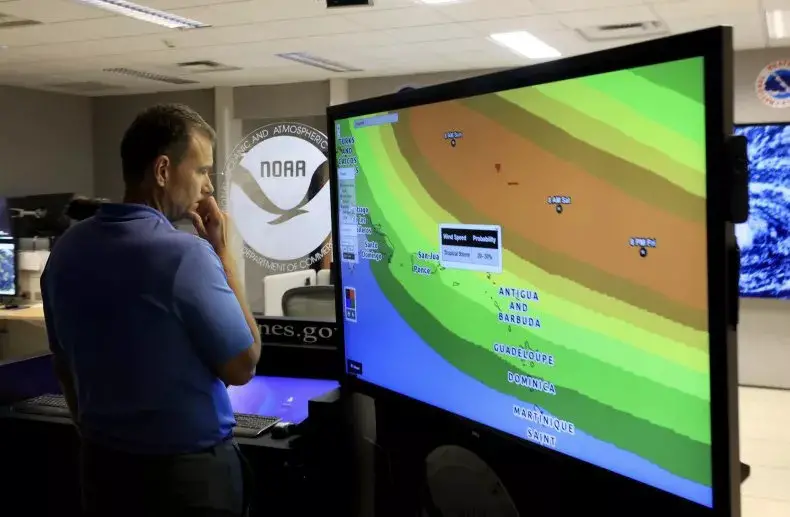National Weather Service Issues Critical Warnings as Powerful Hurricane Approaches
Hurricane Erin has rapidly intensified to historic proportions, prompting emergency preparations along the U.S. East Coast as meteorologists warn of life-threatening conditions and unprecedented storm surge potential.
Rapid Intensification to Historic Category 5 Status
Hurricane Erin has captured the attention of meteorologists and emergency officials nationwide after achieving one of the most dramatic intensification cycles on record. The storm, which initially formed as a Category 1 hurricane with wind speeds of 75 mph, underwent explosive strengthening that brought sustained winds to a devastating 160 mph within just 24 hours.
This rapid intensification has elevated Erin to Category 5 status, making it one of only 43 storms to reach this classification in Atlantic hurricane records. According to the National Weather Service, Category 5 hurricanes represent the most dangerous classification on the Saffir-Simpson Hurricane Wind Scale, with sustained winds exceeding 157 mph and the potential for catastrophic damage across affected regions.
The meteorological phenomenon of rapid intensification, defined as an increase in maximum sustained winds of at least 35 mph within a 24-hour period, has become increasingly common in recent years. Erin’s transformation exemplifies this concerning trend, which often provides limited time for emergency preparations and evacuation procedures.
In case you're wondering what EXTREME rapid intensification looks like (55 mph/13 hours), behold.
Erin is a maelstrom of meteorological mayhem as it puts on a pageant of power and elegance.
It has rapidly intensified at three time the rate needed to qualify. pic.twitter.com/oOtyge5u5U
— Matthew Cappucci (@MatthewCappucci) August 16, 2025
Understanding Category 5 Hurricane Impacts
The National Weather Service provides stark warnings about the destructive potential of Category 5 hurricanes, emphasizing that these storms can cause “catastrophic damage” to infrastructure and communities. According to official guidelines, well-constructed frame homes can sustain severe structural damage, including complete loss of roof systems and exterior walls.
The broader impacts extend far beyond individual structures. Category 5 hurricanes typically snap or uproot most trees in their path, while power lines and utility poles are commonly destroyed. These conditions create long-lasting isolation for residential areas, with power outages potentially lasting weeks to months depending on the extent of infrastructure damage.
Perhaps most significantly, entire regions affected by Category 5 hurricanes may become uninhabitable for extended periods. The combination of structural destruction, utility failures, and compromised transportation networks can render communities unable to support residents until extensive rebuilding and restoration efforts are completed.
Emergency management officials emphasize that these impacts make evacuation and preparation measures critically important, as post-storm recovery can be a prolonged and challenging process requiring substantial resources and coordination between multiple agencies.

Current Storm Track and Coastal Threats
The National Hurricane Center has issued comprehensive warnings regarding Erin’s projected path and associated hazards. Current forecasting models indicate that the hurricane will produce life-threatening surf conditions and dangerous rip currents along an extensive coastline stretching from the Bahamas through much of the U.S. East Coast and extending into Atlantic Canada.
AccuWeather Lead Hurricane Expert Alex DaSilva has provided detailed analysis of the storm’s expected trajectory. “Erin is forecast to slowly curve to the north as it continues to strengthen over the weekend,” DaSilva explained. “At this time, the storm is forecast to remain hundreds of miles off the East Coast.”
Despite maintaining distance from the immediate coastline, the hurricane’s massive size and intensity will generate significant coastal impacts. “Beaches along the entire East Coast, from Florida to New England and Atlantic Canada, will likely experience rough surf and dangerous rip currents as Erin tracks north and eventually northeast,” DaSilva noted.
High-Risk Coastal Areas and Vulnerability Assessment
Meteorologists have identified specific coastal regions that face elevated risk due to their geographic characteristics and exposure to Erin’s effects. Protruding coastal areas are particularly vulnerable to the storm’s impacts, including North Carolina’s Outer Banks, Long Island in New York, and Cape Cod in Massachusetts.
These areas face increased risk due to their extended exposure to open ocean conditions and limited natural barriers to storm surge and high surf. The geographic configuration of these coastal features makes them susceptible to both direct wave action and the secondary effects of storm-driven coastal flooding.
Emergency management officials in these regions have initiated enhanced monitoring procedures and are coordinating with state and federal agencies to ensure appropriate response capabilities are available. Residents and visitors in these areas are advised to stay informed about changing conditions and follow all official guidance regarding beach access and water activities.
Storm Intensity Fluctuations and Forecast Challenges
Hurricane tracking presents ongoing challenges as storms frequently undergo intensity changes throughout their lifecycle. As of early Sunday morning, Hurricane Erin had weakened to Category 3 status, demonstrating the dynamic nature of these weather systems.
However, forecasting models indicate that the storm is likely to regain Category 5 intensity as it continues moving through favorable atmospheric conditions. This potential re-strengthening highlights the importance of maintaining vigilance and preparation efforts even when storms appear to be weakening.
The fluctuation in storm intensity reflects complex interactions between atmospheric conditions, ocean temperatures, and other meteorological factors. Wind shear, sea surface temperatures, and upper-level atmospheric patterns all contribute to a hurricane’s development and can cause rapid changes in storm strength.
These intensity variations present challenges for emergency planning, as officials must prepare for worst-case scenarios while adapting to changing conditions. The potential for re-intensification means that coastal communities must maintain readiness even if current conditions appear less threatening.
Historical Context of the 2025 Hurricane Season
Hurricane Erin’s dramatic development occurs within the context of what meteorologists have predicted to be an above-average Atlantic hurricane season. The National Oceanic and Atmospheric Administration (NOAA) issued seasonal forecasts earlier in 2025 predicting 13 to 19 named storms, significantly higher than historical averages.
This prediction reflects several factors that contribute to increased hurricane activity, including warmer ocean temperatures, favorable atmospheric patterns, and the absence of significant inhibiting factors such as strong wind shear or dust from the Sahara Desert.
The 2025 Atlantic hurricane season, which runs from June 1 through November 30, has already demonstrated the accuracy of these predictions with multiple significant storms. The season’s activity level has important implications for emergency management resources, insurance considerations, and long-term coastal planning initiatives.
Historical data shows that above-average seasons often produce not just more storms, but also more intense hurricanes that pose greater threats to coastal communities. This pattern emphasizes the importance of maintaining preparedness throughout the entire hurricane season rather than focusing only on individual storm events.
Emergency Preparedness and Public Safety Measures
The development of Hurricane Erin serves as a critical reminder of the importance of comprehensive hurricane preparedness, particularly for residents of coastal areas. Emergency management officials emphasize that preparation should begin well before storms approach, as last-minute evacuation and supply gathering can be dangerous and ineffective.
Essential preparation measures include developing family evacuation plans, assembling emergency supply kits with sufficient provisions for extended power outages, and staying informed about official weather updates and emergency management guidance. Property owners should also ensure they have appropriate insurance coverage and understand their policies’ specific provisions regarding hurricane damage.
For coastal residents, understanding local evacuation zones and routes is particularly crucial. Many coastal areas have specific evacuation procedures based on storm surge projections, and residents should be familiar with these plans before emergency conditions develop.
Business owners and institutional facilities also need comprehensive hurricane preparedness plans that address both immediate safety concerns and long-term continuity issues. These plans should include provisions for protecting property, ensuring employee safety, and maintaining critical operations during and after storm events.
Technological Advances in Hurricane Forecasting
The rapid intensification of Hurricane Erin highlights both the capabilities and limitations of modern hurricane forecasting technology. Advances in satellite imagery, computer modeling, and atmospheric monitoring have significantly improved meteorologists’ ability to track storm development and predict intensity changes.
However, rapid intensification events like Erin’s transformation still present forecasting challenges. The complex atmospheric and oceanic interactions that drive these dramatic changes are not always fully captured by current modeling systems, making precise timing and intensity predictions difficult.
Recent technological improvements include enhanced satellite monitoring capabilities, improved ocean temperature measurements, and more sophisticated computer models that can process larger amounts of atmospheric data. These advances have contributed to more accurate track forecasting and earlier warnings for coastal communities.
Despite these improvements, meteorologists emphasize that hurricane forecasting remains an evolving science with inherent uncertainties. This reality underscores the importance of preparing for a range of possible scenarios rather than relying on single-point forecasts.
Climate Change Implications and Future Trends
The intensity and rapid development of Hurricane Erin occur within the broader context of changing climate patterns that may be influencing hurricane behavior. Scientific research suggests that warming ocean temperatures and changing atmospheric conditions may be contributing to more intense hurricanes and more frequent rapid intensification events.
While individual storms cannot be directly attributed to climate change, the overall patterns observed in recent hurricane seasons align with predictions about how tropical cyclone behavior may evolve. These changes have important implications for long-term coastal planning, infrastructure development, and emergency management strategies.
Coastal communities are increasingly incorporating climate change projections into their planning processes, including considerations of sea level rise, changing storm surge patterns, and evolving precipitation patterns associated with tropical systems.
Conclusion: Vigilance and Preparation Remain Essential
Hurricane Erin’s dramatic intensification and projected impacts serve as a powerful reminder of the destructive potential of major hurricanes and the importance of comprehensive preparedness measures. As the storm continues its northward trajectory, coastal communities from the Bahamas to Atlantic Canada must remain vigilant and ready to respond to changing conditions.
The 2025 hurricane season’s above-average activity level means that Erin may not be the only significant threat coastal areas face in the coming months. Maintaining readiness throughout the entire season, staying informed about official weather updates, and following emergency management guidance will be essential for protecting lives and property.
As forecasting technology continues to evolve and our understanding of hurricane behavior improves, the fundamental importance of preparation, vigilance, and respect for these powerful natural phenomena remains unchanged. Hurricane Erin’s development serves as both a demonstration of nature’s power and a call for continued commitment to hurricane safety and preparedness.
Stay informed about Hurricane Erin’s development through official weather services and emergency management agencies. Have you completed your hurricane preparedness planning for this season? Share your preparation tips and experiences in the comments below.

Adrian Hawthorne is a celebrated author and dedicated archivist who finds inspiration in the hidden stories of the past. Educated at Oxford, he now works at the National Archives, where preserving history fuels his evocative writing. Balancing archival precision with creative storytelling, Adrian founded the Hawthorne Institute of Literary Arts to mentor emerging writers and honor the timeless art of narrative.
